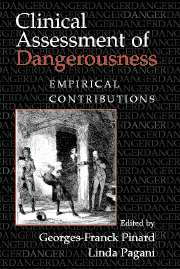Book contents
- Frontmatter
- Contents
- Contributors
- Prologue
- Introduction
- Basic Issues in Violence Research
- Mental Health Issues and Dangerousness
- 5 Major Mental Disorder and Violence: Epidemiology and Risk Assessment
- 6 Axis II Disorders and Dangerousness
- 7 Recidivistic Violent Behavior and Axis I and Axis II Disorders
- Family Issues and Dangerousness
- Individual Characteristics and Dangerousness
- Conclusion
- Index
6 - Axis II Disorders and Dangerousness
Published online by Cambridge University Press: 03 July 2009
- Frontmatter
- Contents
- Contributors
- Prologue
- Introduction
- Basic Issues in Violence Research
- Mental Health Issues and Dangerousness
- 5 Major Mental Disorder and Violence: Epidemiology and Risk Assessment
- 6 Axis II Disorders and Dangerousness
- 7 Recidivistic Violent Behavior and Axis I and Axis II Disorders
- Family Issues and Dangerousness
- Individual Characteristics and Dangerousness
- Conclusion
- Index
Summary
Introduction
Axis II disorders include a variety of personality disorders and mental retardation. A personality disorder is “an enduring pattern of inner experience and behavior that deviates markedly from expectations of the individual's culture, is pervasive and inflexible, has an onset in adolescence or early adulthood, is stable over time and leads to distress of impairment” (American Psychiatric Association [APA], 1994). Dangerous behaviors (i.e., violence or suicide attempts) are mostly found among individuals with personality disorders included in Cluster B Category: Antisocial, Borderline, Histrionic, and Narcissistic Personality Disorders. Individuals with Cluster B Personality Disorders often appear dramatic, emotional, and/or erratic. Individuals with Paranoid Personality Disorder, which is in Cluster A, talk about violence but are usually not violent (Tardiff, 1998). The other personality disorders in Cluster A, Schizoid and Schizotypal Personality Disorders, and those in Cluster C (Avoidant, Dependent, and Obsessive Compulsive Personality Disorders) are not dangerous although occasionally violent or suicidal behaviors may occur if they feel angry or depressed or have an accompanying Axis I disorder, which is linked to violent or suicidal behavior. Some individuals with mental retardation are violent as a consequence of frustration and an inability to express themselves verbally.This chapter will focus on personality disorders in Cluster B and Paranoid Personality Disorder, since these are the most frequent and challenging cases where the clinician must decide whether the patient is a short-term risk for violence or suicidal behavior.
- Type
- Chapter
- Information
- Clinical Assessment of DangerousnessEmpirical Contributions, pp. 103 - 120Publisher: Cambridge University PressPrint publication year: 2000
- 4
- Cited by



